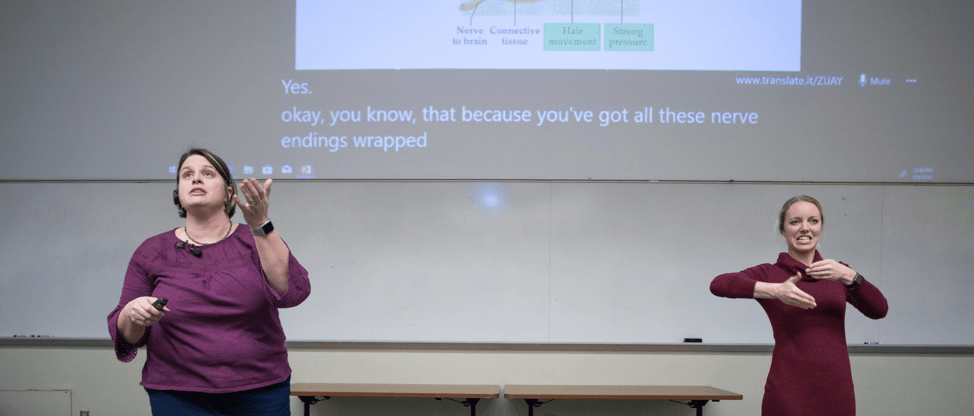AI-powered “Accessibility by Design”: Using Microsoft Cognitive Services to empower people with disabilities

How Microsoft and its partners are harnessing the power of AI and Machine Learning to empower 1 Billion people in the world living with a disability
Background: Microsoft Cognitive Services
Microsoft is one of the three largest enterprise cloud providers, competing amongst others with Amazon and IBM. Its cloud service, Azure, generated $18.6B in 2017 [1]. Azure provides businesses with a vast set of computing services such as storage, databases, and machine learning capabilities delivered over the internet. Microsoft’s suite of AI offerings, known as Microsoft Cognitive Services, is one of the largest in the industry and allows businesses to execute machine and deep-learning algorithms easily, without having to invest in expensive and specialized infrastructure [2]. Leveraging Microsoft Cognitive Services, developers can harness the power of AI in areas such as Vision, Speech, Language, and Search.
Cloud & AI: Satya Nadella’s strategic vision for Microsoft
Microsoft CEO Satya Nadella is investing heavily in the company’s Cloud & AI business. In his book ‘Hit Refresh’ [3], he outlines his vision for the future of the company, which is largely driven by the growth of its Cloud platform. In fact, advances in AI & machine learning have unlocked unprecedented possibilities that are changing the way Microsoft can serve its mission to “empower every person and every organization on the planet to achieve more”. In his address to the developer community at the Microsoft BUILD annual developer conference in May 2018, Satya Nadella also brought attention the tech giant’s responsibility in ensuring that “the technology [built] is trusted and benefits all” [4].
AI for Accessibility: Empowering over 1 Billion people to achieve more
Going a step further, Satya Nadella’s personal goal and an integral part of his strategic vision for the company is to create products and services that are inclusive and accessible by design [5].
One important community that has historically been underserved in the industry are the over 1 Billion people in the world living with a disability. As technology permeates through more and more aspects of our lives e.g. social, workplace, education, and only 1 out of 10 people with disabilities have access to assistive technology [6], this group is one of the most at risk of being further marginalized in the digital world. AI has a big role to play in filling this gap.
This also represents a huge opportunity for Microsoft to set its cloud service apart as the leading innovation platform in this area. As part of the company’s commitment to push accessible innovation forward, it recently launched AI for Accessibility, a $25 million, five-year program aimed at empowering people with disabilities through AI. The program combines innovation grants, technology investments, and will incorporate AI for Accessibility innovations into Microsoft’s cloud services [7]. The first grantee of the program, Zyrobotics, developed ‘ReadAble Storiez’, a reading fluency program that uses Microsoft Cognitive Services to create personalized content for children with a wide range of learning needs and empowers families who don’t have access to a speech therapist [8].
A two-fold approach to product innovation: partnerships and internal R&D
Prior to the official launch of AI for Accessibility, several companies had already started leveraging Microsoft’s Cognitive Services APIs to support people with disabilities in their day-to-day lives. Microsoft Translator [9] was developed in collaboration with the Rochester Institute of Technology (RIT) and helps deaf or hard-of-hearing people follow conversations with real-time captioning.

Figure 1: Microsoft Translator used in an RIT lecture
Helpicto [10] is an application developed by a French startup that helps children with autism and their families better communicate with one another by turning voice commands into images.
Figure 2: Helpicto, an application helping children with autism and their families communicate more effectively
In addition to its external partnerships, Microsoft is also differentiating its core offerings through AI-powered, accessible design. Starting in Windows 10, Microsoft introduced Eye control capability, enabling people with mobility impairments such as a motor neuron disease to control their computer through eye movement. [11]
Figure 3: Windows Eye Control
Seeing AI is another powerful mobile application that helps people with visual impairments navigate their day-to-day life by narrating the world around them [12].
Going forward: Recommendations
My recommendation would be for Microsoft to solidify its position as an industry leader in accessible digital design to better serve its mission and differentiate itself against competitors.
To do so, the company needs to reinforce its investment in the area of AI-powered, accessible design, both internally and through external partnerships, incubation programs, and acquisitions.
It also needs to continue adding value to, and expand the Azure ecosystem through R&D investments in cloud and AI.
Finally, the company should continue to push for product development processes that are customer-obsessed and inclusive by design. This will require a continued shift in the culture and training across all the stakeholders involved in the development process.
Open Question
In order for Microsoft to bring the power of AI to every person on the planet, the company needs to think about how to best serve customers in locations where internet connectivity is not ubiquitous. How can product innovation help fill this gap? (784)
References
[3] https://news.microsoft.com/hitrefresh/
[6] http://www.who.int/en/news-room/fact-sheets/detail/assistive-technology
[7] https://blogs.msdn.microsoft.com/accessibility/2018/05/07/ai-for-accessibility/
[9] http://customers.microsoft.com/en-us/story/rit-higher-education-cognitive-services
[10]https://microsoft.github.io/techcasestudies/cognitive%20services/2017/08/04/equadexcognitives.html






I really enjoyed this post. It’s inspiring to hear about companies like Zyrobotics that are democratizing access to health and support services such as speech therapy. Your point about the lack of internet access in other parts of the world is a good one. Since Microsoft is clearly working to improve the lives of others by supporting companies like Zyrobotics, I think their efforts to get more people online would be well received. In contrast, I’ve seen other technology companies receive backlash as they connect more people to the web – for example, is was Facebook’s Internet.org initiative socially-motivated, or were they purely trying to create additional users for their product? Again, I don’t think Microsoft would face such harsh criticism, since the benefits of these disability-oriented programs are so obvious, it’s just food for thought!
Very interesting article!! I love what Microsoft is doing by trying to democratize technology to people living disabilities. But most of all, it is very inspiring to see how technology can actually solve daily issues that people with disabilities are facing (such as being able to understand your environment and read people’s expression). While I think these technologies are still at their early stages, I feel that it is the role of society as a whole to make a progress in that field and not only the role of a single company. Maybe one idea could be to create a think-thank that bring all stakeholders and players working on these issues together to help innovation and research go even further. This think thank would also involve the government to ensure that the technology canoe democratized (at a fair price or even covered by insurance companies). My hope is that technology could drastically improve people with disabilities’ lives but also that it could be affordable by as many people as possible!
Thanks for exposing us to this important application of AI and machine learning! In an era where it feels like so many technological advances (especially ones that incorporate machine learning) have the potential to exclude and marginalize already oppressed communities, it’s exciting and inspiring to hear about a series of innovations that are genuinely inclusive and empowering. I’d love to learn more about Microsoft’s product development process — to what extent are people with disabilities invited to participate in the design process? Relatedly, is Microsoft hiring people with disabilities, both to create these products and more generally across the firm? This is another important step Microsoft could take to be a leader in empowering this community.
Thank you for your comment! To respond to your proposal/question: Microsoft is actually doing more and more in this space and hiring folks who are living with a disability full time to both help with this effort but also be part of the design and development process as a whole. I think a key area that still needs to be worked on is to make it clear for everyone involved in the development process just how critical it is to follow an inclusive design process from the start and seek feedback throughout. One pitfall I’ve witnessed is that accessibility can sometimes be overlooked when projects are time or resource constraints or management on a particular team has not sent a clear message about the importance of making products accessible and inclusive.
This is awesome! Thanks for following up 🙂 I hear you about the challenge of prioritizing this work, since it’s a relatively small population that would benefit from these technologies and they’re not incredibly lucrative — I’ve experienced similar tensions in corporate social impact work more generally. Excited to follow Microsoft’s work in this space!